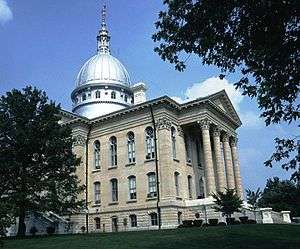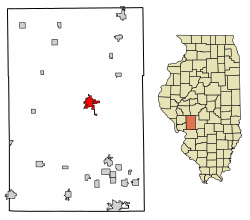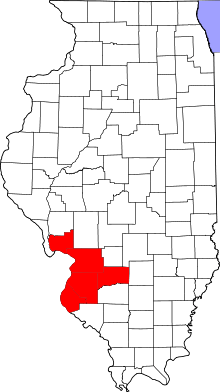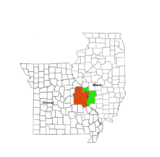Carlinville, Illinois
Carlinville is a city in Macoupin County, Illinois, United States.
Carlinville | |
|---|---|
City | |
 Macoupin County Courthouse in Carlinville | |
 Location of Carlinville in Macoupin County, Illinois. | |
.svg.png) Location of Illinois in the United States | |
| Coordinates: 39°16′N 89°53′W | |
| Country | United States |
| State | Illinois |
| County | Macoupin |
| Founded | 1865 |
| Government | |
| • Mayor | Deanna Demuzio |
| Area | |
| • Total | 3.37 sq mi (8.72 km2) |
| • Land | 3.37 sq mi (8.72 km2) |
| • Water | 0.00 sq mi (0.00 km2) |
| Elevation | 619 ft (189 m) |
| Population (2010) | |
| • Total | 5,917 |
| • Estimate (2019)[2] | 5,481 |
| • Density | 1,626.89/sq mi (628.24/km2) |
| Time zone | UTC-6 (CST) |
| • Summer (DST) | UTC-5 (CDT) |
| ZIP Code(s) | 62626 |
| Area code(s) | 217 |
| FIPS code | 17-11202 |
| Wikimedia Commons | Carlinville, Illinois |
| Website | www www |
As of the 2010 Census, the population was 5,917, and 5,543 at a 2018 estimate. It is the county seat of Macoupin County.[3]
Carlinville is also the home of Blackburn College, a small college affiliated with the Presbyterian church, and the former home of Prairie Farms Dairy.
History
Carlinville is named for Thomas Carlin,[4] 7th Governor of Illinois, who as a member of the state legislature was instrumental in creating Macoupin County.
Carlinville has long been a site of Illinois history, and has played host to many presidential hopefuls via campaign stops at a time in American history when railway routes produced many visits by politicians. Perhaps the largest and most important hallmark of Carlinville's history is its courthouse, the largest built outside of New York City at the time of its erection. Built in 1870 and designed by famous state capitol building architect Elijah E. Myers, the construction of Carlinville's courthouse produced its candidacy for the location of the State Capitol. Locally, it is known as "The Million Dollar Courthouse" due to its cost overruns at the time it was built.
In the early 1900s Carlinville became the site of a great many Sears Catalog Homes. An entire neighborhood was constructed of the homes and was funded, in 1918, by Standard Oil of Indiana for its mineworkers in Carlinville, at a cost of approximately 1 million dollars. In gratitude, Sears, Roebuck named one of its house models the "Carlin." Today 149 of the original 156 homes still exist, the largest single repository of Sears Catalog Homes in the United States.[5]
One notable resident of Carlinville was American entomologist Charles Robertson, who carried out what is still the single most intensive study of flower-visiting insects of a single locality (Carlinville), culminating in a 221-page book published in 1928 under the title Flowers and Insects. From among the specimens he collected in the process of doing this study, he named over 100 new species of bees and wasps. Scientists in 1970–1972 did a similar survey, and found that most of the bees noted by Robertson were still present. This is presumably due to the existence of bee habitat in hedgerows, on slopes, and in other non-agricultural land in the survey area.[6][6]
Other notable Carlinvillians include nature writer and novelist Mary Hunter Austin, once called "the most intelligent woman in America" by H.G. Wells,[7] distinguished military personnel, politicians, and others.
Geography
According to the 2010 census, Carlinville has a total area of 2.99 square miles (7.74 km2), all land.[8]
Demographics
| Historical population | |||
|---|---|---|---|
| Census | Pop. | %± | |
| 1880 | 3,117 | — | |
| 1890 | 3,293 | 5.6% | |
| 1900 | 3,502 | 6.3% | |
| 1910 | 3,616 | 3.3% | |
| 1920 | 5,212 | 44.1% | |
| 1930 | 4,144 | −20.5% | |
| 1940 | 4,965 | 19.8% | |
| 1950 | 5,116 | 3.0% | |
| 1960 | 5,440 | 6.3% | |
| 1970 | 5,675 | 4.3% | |
| 1980 | 5,439 | −4.2% | |
| 1990 | 5,416 | −0.4% | |
| 2000 | 5,685 | 5.0% | |
| 2010 | 5,917 | 4.1% | |
| Est. 2019 | 5,481 | [2] | −7.4% |
| U.S. Decennial Census[9] | |||
As of the census[10] of 2000, there were 5,685 people, 2,125 households, and 1,393 families residing in the city. The population density was 2,390 people per square mile (922/km2). There were 2,289 housing units at an average density of 962.3 per square mile (371.3/km2). The racial makeup of the city was 97.01% White, 1.50% African American, 0.25% Native American, 0.26% Asian, 0.02% Pacific Islander, 0.23% from other races, and 0.74% from two or more races. Hispanic or Latino of any race were 0.76% of the population.
There were 2,125 households, of which 31.1% had children under the age of 18 living with them, 50.3% were married couples living together, 11.3% had a female householder with no husband present, and 34.4% were non-families. 30.1% of all households were made up of individuals and 15.9% had someone living alone who was 65 years of age or older. The average household size was 2.38 and the average family size was 2.96.
In the city, the population was spread out with 23.4% under the age of 18, 12.8% from 18 to 24, 25.1% from 25 to 44, 19.4% from 45 to 64, and 19.4% who were 65 years of age or older. The median age was 37 years. For every 100 females, there were 89.7 males. For every 100 females age 18 and over, there were 84.1 males.
The median income for a household in the city was $34,259, and the median income for a family was $39,693. Males had a median income of $35,137 versus $21,286 for females. The per capita income for the city was $16,663. About 9.0% of families and 12.5% of the population were below the poverty line, including 15.3% of those under age 18 and 14.6% of those age 65 or over.
Transportation
Illinois Route 4 directly passes through Carlinville. Interstate 55 is also within 12 miles (19 km) of the city. Illinois Route 108 Passes through Carlinville from Interstate 55 to the East, to Kampsville, Illinois, where it crosses the Illinois River on a free, state-operated ferry. Alongside a developed road network, the Carlinville Amtrak station is also served directly by five daily trains, offering easy access south to St. Louis and north to Springfield and Chicago. One train is the Texas Eagle which connects Chicago to Texas and features sleeping cars, a dining car and a lounge.
Freight rail service is provided by the Union Pacific Railroad, formerly the Gulf, Mobile and Ohio, the Illinois Central Gulf, the Chicago, Missouri and Western, and the Southern Pacific Chicago - St. Louis Railways. The main line of the GM&O passed through Carlinville.
The Illinois Terminal Railroad, an electric interurban to St. Louis from Springfield that once provided both freight and passenger service, passed down the middle of Carlinville's West Street. It was still operating freight trains on West Street to a nearby grain elevator into the 1970s. Its trestle crossing Goat Hollow south of Carlinville burned severing the line, which was then abandoned. A small portion of the line is used by Monterey Coal Co. mine to connect with the former Chicago and North Western Transportation Company L & M District], serving coal-fired power plants.
Notable people
- Walter Stratton Anderson (1881–1981), United States Vice Admiral
- Mary Hunter Austin (1868–1934), writer
- Dana J. Boente (1954– ), General Counsel of the FBI and former Acting Attorney General of the United States
- William A. Boring (1859–1934), architect
- Kelsey Card (1992- ), Olympic discus thrower
- Louis P. Daley (1868–1930), Illinois state representative
- Vince Demuzio (1941-2004), Illinois State Senator and Chairman of the Illinois Democratic Party
- Palemon Howard Dorsett (1862–1943), American horticulturalist
- Cornelius J. Doyle (1871–1938), Illinois Secretary of State
- David Gore (1823–1911), Illinois State Senator and State Auditor
- Mark Juergensmeyer (1940– ), American religious scholar
- Truman H. Landon (1905–1986), United States Air Force General
- Louis John Lanzerotti (1938- ), Research Professor of Physics, New Jersey Institute of Technology
- Gustave Loehr (1864–1918), Co-founder of Rotary International
- Peter F. Mack, Jr. (1916–1986), U.S. Representative from Illinois
- William Moise (1922–1980), artist
- William L. Mounts (1862–1929), Illinois state legislator, lawyer, and mayor of Carlinville
- John McAuley Palmer (1870–1955), United States Army General
- Charles Robertson (1858–1935), entomologist
- Richard Rowett (1830-1887), Civil War officer and horse breeder
- W. O. Woods (1873-1951), Treasurer of the United States
References
- "2019 U.S. Gazetteer Files". United States Census Bureau. Retrieved July 14, 2020.
- "Population and Housing Unit Estimates". United States Census Bureau. May 24, 2020. Retrieved May 27, 2020.
- "Find a County". National Association of Counties. Archived from the original on 2011-05-31. Retrieved 2011-06-07.
- Gannett, Henry (1905). The Origin of Certain Place Names in the United States. Govt. Print. Off. pp. 69.
- Hastings, Deborah (16 April 2007). "Push to catalog mail-order homes". The Associated Press. Retrieved 3 July 2017 – via LA Times.
- Marlin, J. C. and W. E. LaBerge (2001), "The native bee fauna of Carlinville, Illinois, revisited after 75 years: a case for persistence", Conservation Ecology, 5 (1): 9
- Kort, Carol (2007), A to Z of American women writers, ISBN 978-0-8160-6693-3))
- "G001 - Geographic Identifiers - 2010 Census Summary File 1". United States Census Bureau. Archived from the original on 2020-02-13. Retrieved 2015-12-25.
- "Census of Population and Housing". Census.gov. Retrieved June 4, 2015.
- "U.S. Census website". United States Census Bureau. Retrieved 2008-01-31.

